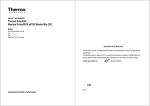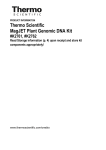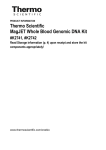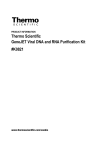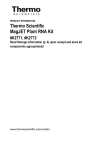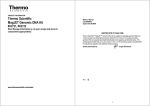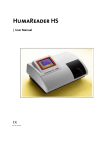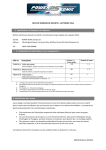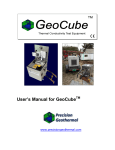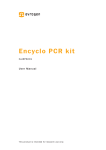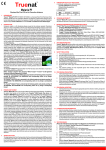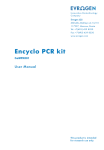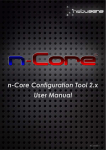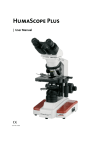Download Phusion Green Hot Start II High-Fidelity DNA Polymerase, #F-537L
Transcript
1. Introduction PRODUCT INFORMATION Thermo Scientific Phusion Green Hot Start II High-Fidelity DNA Polymerase #F-537L 500 U Lot __ Expiry Date __ Store at -20°C www.thermoscientific.com/onebio Ordering information Component Phusion Hot Start II DNA Polymerase 5X Phusion Green HF Buffer 5X Phusion Green GC Buffer 50 mM MgCl2 solution 100% DMSO #F-537S 100 U #F-537L 500 U 50 μL 250 μL 2 1.5 mL 6 1.5 mL 1.5 mL 2 1.5 mL 1.5 mL 2 1.5 mL 500 μL 500 μL Reaction buffer: 5X Phusion Green HF Buffer and 5X Phusion Green GC Buffer both contain 7.5 mM MgCl2. Thermo Scientific™ Phusion™ Hot Start II High-Fidelity DNA Polymerase offers superior performance for all PCR applications. A unique processivity-enhancing domain makes this Pyrococcus-like proofreading enzyme extremely processive, accurate and rapid. The error rate of Phusion Hot Start II DNA Polymerase is equal to that of Phusion DNA Polymerase (4.4 10-7 in Phusion HF-buffer) when determined with a modified lacI-based method1. It is approximately 50-fold lower than that of Thermus aquaticus DNA polymerase and 6-fold lower than that of Pyrococcus furiosus DNA polymerase. Phusion Hot Start II High-Fidelity DNA Polymerase is capable of amplifying long amplicons such as the 7.5 kb genomic and 20 kb λ DNA used in Thermo Fisher Scientific quality control assays. Phusion Hot Start II DNA Polymerase combines the DNA polymerase and a reversibly bound, specific Affibody® protein2,3, which inhibits the DNA polymerase activity at ambient temperatures, thus preventing the amplification of non-specific products. In addition, the Affibody ligand inhibits the 3’→5’ exonuclease activity of the polymerase, preventing degradation of primers and template DNA during reaction setup. At polymerization temperatures, the Affibody molecule is released, rendering the polymerase fully active. Phusion Hot Start II DNA Polymerase does not require any separate activation step in the PCR protocol. The 5X Phusion Green HF Buffer and 5X Phusion Green GC Buffer include a density reagent and two tracking dyes for direct loading of PCR products on a gel. The colored buffer does not interfere with PCR performance and is compatible with downstream applications such as DNA sequencing, ligation and restriction digestion. For applications that require PCR product analysis by absorbance or fluorescence excitation, we recommend using the colorless 5X Phusion HF Buffer (F-518) or 5X Phusion GC Buffer (F-519) or purifying the PCR product prior to analysis. 2. Important Notes Rev.1 Use Phusion DNA Polymerase at 0.5–1.0 U per 50 μL reaction volume. Do not exceed 2 U/50 μL (see 4.1). Use 15–30 s/kb for extension. Do not exceed 1 min/kb (see 5.4). Use 98°C for denaturation (see 5.1 & 5.2). The annealing rules are different from many common DNA polymerases (such as Taq DNA polymerases). Read Section 5.3 carefully. Use 200 μM of each dNTP. Do not use dUTP (see 4.3). Phusion DNA Polymerases produce blunt end DNA products. 3. Guidelines for using Phusion Hot Start II DNA Polymerase Carefully mix and centrifuge all tubes before opening to ensure homogeneity and improve recovery. When using Phusion Hot Start II DNA Polymerase, it is not necessary to perform the PCR setup on ice. Prepare a master mix for the appropriate number of samples to be amplified. The DNA polymerase should be pipetted carefully and gently as the high glycerol content (50%) in the storage buffer may otherwise lead to pipetting errors. Protocols optimized for Phusion DNA Polymerase can be applied to Phusion Hot Start II DNA Polymerase reactions. Due to the novel nature of Phusion Hot Start II DNA Polymerase, the optimal reaction conditions may differ from PCR protocols for standard DNA polymerases. Due to the high salt concentration in the reaction buffer, Phusion Hot Start II DNA Polymerase tends to work better at elevated denaturation and annealing temperatures. Please pay special attention to the conditions listed below when running your reactions. Following the guidelines will ensure optimal enzyme performance. Table 1. Pipetting instructions (add items in this order) Component 20 µL rxn H2O Add to 20 µL add to 50 µL 50 µL rxn Final conc. 5X Phusion Green HF 4 µL Buffer* 10 µL 1X 10 mM dNTPs 0.4 µL 1 µL 200 µM each Primer A** X µL X µL 0.5 µM Primer B** X µL X µL 0.5 µM Template DNA X µL X μL (DMSO***, optional) (0.6 µL) (1.5 µL) (3%) Phusion Hot Start II DNA Polymerase (2 U/µL) 0.2 µL 0.5 µL 0.02 U/µL * Optionally 5X Phusion Green GC Buffer can be used. See section 4.2. for details. ** The recommendation for final primer concentration is 0.5 μM, but it can be varied in a range of 0.2–1.0 μM if needed. *** Addition of DMSO is recommended for GC-rich amplicons. DMSO is not recommended for amplicons with very low GC % or amplicons that are ≥20 kb. Table 2.Cycling instructions 2-step protocol 3-step protocol Temp. Time Temp. Time 98°C 30 s 98°C 30 s 98°C - 5-10 s - 98°C X°C 5-10 s 10-30 s 72°C 15-30 s/kb 72°C 15-30 s/kb 72°C 4°C 5-10 min hold 5-10 min hold Cycle step Initial denaturation Denaturation Annealing (see 5.3) Extension (see 5.4) Final Extension Cycles 72°C 4°C 1 25-35 1 4. Notes about reaction components 4.1. Enzyme The optimal amount of enzyme depends on the amount of template and the length of the PCR product. Usually 1 unit of Phusion Hot Start II DNA Polymerase per 50 μL reaction volume gives good results, but the optimal amount can range from 0.5 to 2 units per 50 μL reaction depending on the amplicon length and difficulty. Do not exceed 2 U/50 μL (0.04 U/μL), especially for amplicons that are >5 kb. When cloning fragments amplified with Phusion Hot Start II DNA Polymerase, blunt end cloning is recommended. If TA cloning is required, it can be performed by adding A overhangs to the blunt PCR product with Taq DNA Polymerase, for example. However, before adding the overhangs it is very important to remove all Phusion Hot Start II DNA Polymerase by purifying the PCR product carefully. Any remaining Phusion Hot Start II DNA Polymerase will degrade the A overhangs, creating blunt ends again. A detailed protocol for TA cloning of PCR fragments amplified with any of the Phusion DNA Polymerases can be found on website: www.thermoscientific.com/pcrcloning. 4.2. Buffers Two buffers are provided with the enzyme: 5X Phusion Green HF Buffer and 5X Phusion Green GC Buffer. The error rate of Phusion Hot Start II DNA Polymerase in HF Buffer (4.4 10-7) is lower than that in GC Buffer (9.5 10-7). Therefore, HF Buffer should be used as the default buffer for high-fidelity amplification. However, GC Buffer can improve the performance of Phusion Hot Start II DNA Polymerase on some difficult or long templates, such as GC-rich templates or those with complex secondary structures. For applications such as microarray or DHPLC, where the DNA templates need to be free of detergents, noncolored detergent-free reaction buffers are available for Phusion DNA Polymerases. 4.3. Mg2+ and dNTP The concentration of Mg2+ is critical since Phusion Hot Start II DNA Polymerase is a magnesium-dependent enzyme. Excessive Mg2+ stabilizes the DNA double strand and prevents complete denaturation of DNA. Excess Mg2+ can also stabilize spurious annealing of primers to incorrect template sites and decrease specificity. Conversely, inadequate Mg2+ may lead to lower product yield. The optimal Mg2+ concentration also depends on the dNTP concentration, the specific template DNA and the sample buffer composition. In general, the optimal Mg2+ concentration is 0.5 to 1 mM over the total dNTP concentration for standard PCR. If the primers and/or template contain chelators such as EDTA or EGTA, the apparent Mg2+ optimum may be shifted to higher concentrations. If further optimization is needed, increase Mg2+ concentration in 0.2 mM steps. High quality dNTPs should be used for optimal performance with Phusion Hot Start II DNA Polymerase. The polymerase cannot read dUTP-derivatives or dITP in the template strand so the use of these analogues or primers containing them is not recommended. Due to the high processivity of Phusion Hot Start II DNA Polymerase there is no advantage of increasing dNTP concentrations. For optimal results always use 200 μM of each dNTP. 4.4. Template General guidelines for low complexity DNA (e.g. plasmid, lambda or BAC DNA) are: 1 pg–10 ng per 50 μL reaction volume. For high complexity genomic DNA, the amount of DNA template should be 50–250 ng per 50 μL reaction volume. If cDNA synthesis reaction mixture is used as a source of template, the volume of the template should not exceed 10% of the final PCR reaction volume. 5.4. Extension The extension should be performed at 72°C. The extension time depends on the length and complexity of the amplicon. For low complexity DNA (e.g. plasmid, lambda or BAC DNA) use an extension time of 15 seconds per 1 kb. For high complexity genomic DNA, 30 seconds per 1 kb is recommended. For some cDNA templates, the extension time can be increased up to 40 seconds per 1 kb to obtain optimal results. 4.5. PCR additives The recommended reaction conditions for GC-rich templates include 3% DMSO as a PCR additive, which aids in the denaturing of templates with high GC content. For further optimization DMSO should be increased in 2% steps. In some cases DMSO may also be required for supercoiled plasmids to relax for denaturation. Other PCR additives such as formamide (up to 3%), glycerol and betaine are also compatible with Phusion Hot Start II DNA Polymerase. If high DMSO concentration is used, the annealing temperature must be decreased, as DMSO affects the melting point of the primers. It has been reported that 10% DMSO decreases the annealing temperature by 5.5–6.0°C4. 6. Troubleshooting 5. Notes about cycling conditions 5.1. Initial denaturation Denaturation should be performed at 98°C. Due to the high thermostability of Phusion Hot Start II DNA Polymerase even higher than 98°C denaturation temperatures can be used. We recommend a 30-second initial denaturation at 98°C for most templates. Some templates may require longer initial denaturation time, and the length of the initial denaturation time can be extended up to 3 minutes. 5.2. Denaturation Keep the denaturation time as short as possible. Usually 5–10 seconds at 98°C is enough for most templates. Note: the denaturation time and temperature may vary depending on the ramp rate and temperature control mode of the cycler. 5.3. Primer annealing The optimal annealing temperature for Phusion Hot Start II DNA Polymerase may differ significantly from that of Taq-based polymerases. Always use the Tm calculator and instructions on website: www.thermoscientific.com/pcrwebtools to determine the Tm values of primers and optimal annealing temperature. As a basic rule, for primers >20 nt, anneal for 10–30 seconds at a Tm +3°C of the lower Tm primer. For primers ≤20 nt, use an annealing temperature equal to the Tm of the lower Tm primer. If necessary, use a temperature gradient to find the optimal annealing temperature for each template-primer pair combination. The annealing gradient should extend up to the extension temperature (two-step PCR). A 2-step protocol is recommended when primer Tm values are at least 69°C (>20 nt) or 72°C (≤20 nt) when calculated with Thermo Scientific’s Tm calculator. In the 2-step protocol the combined annealing/extension step should be performed at 72°C even when the primer Tm is >72°C. No product at all or low yield Repeat the PCR and Decrease annealing make sure that there are temperature. no pipetting errors. Optimize enzyme Use Thermo Scientific’s concentration. Tm calculator Titrate DMSO (2–8 %) in the www.thermoscientific.com/ reaction (see section 4.5). pcrwebtools. Denaturation temperature Use fresh high-quality may be too low. Optimal dNTPs. denaturation temperature Do not use dNTP mix or for most templates is 98°C primers that contain dUTP or higher. or dITP. Denaturation time may be Sample concentration may too long or too short. be too low. Use more Optimize denaturation time. template. Check the purity and Template DNA may be concentration of the damaged. Use carefully primers. purified template. Check primer design. Increase extension time. Try using the alternative GC Increase the number of Buffer (see section 4.2). cycles. Non-specific products - High molecular weight smears Decrease enzyme Vary denaturation concentration temperature (see section (see section 4.1). 5.2). Decrease extension time Optimize Mg2+ concentration (see section 5.4). (see section 4.3). Reduce the total number Reduce primer of cycles. concentration. Increase annealing temperature or try 2-step protocol (see section 5.3). Non-specific products - Low molecular weight discrete bands Increase annealing Optimize Mg2+ concentration temperature (see section 4.3). (see section 5.3). Titrate template amount. Shorten extension time Decrease primer (see section 5.4). concentration. Reduce enzyme Design new primers. concentration (see section 4.1). 7. Component specifications CERTIFICATE OF ANALYSIS 7.1. Phusion Hot Start II High-Fidelity DNA Polymerase (F-549) Thermostable Phusion DNA Polymerase is isolated and purified froman E.coli strain expressing the cloned Phusion DNA Polymerase gene. Phusion DNA Polymerase possesses the following activities: 5’→3’ DNA polymerase activity and 3’→5’ exonuclease activity. The Affibody ligand is isolated and purified from an E.coli strain expressing the cloned Affibodyencoding gene. Storage buffer: 20 mM Tris-HCl (pH 7.4 at 25°C), 0.1 mM EDTA, 1 mM DTT, 100 mM KCl, stabilizers, 200 μg/mL BSA and 50 % glycerol. Unit definition: One unit is defined as the amount of enzyme that will incorporate 10 nmoles of dNTPs into a polynucleotide fraction at 74°C in 30 min. Enzyme activity is assayed in the following mixture: 25 mM TAPS-HCl, pH 9.3 (at 25°C), 50 mM KCl, 2 mM MgCl2, 1 mM β-mercaptoethanol, 0.75 mM activated salmon milt DNA, 100 μM dCTP, 200 μM each dATP, dGTP, dTTP, 0.4 MBq/ml [3H] dCTP. Endonuclease contamination assay No endonuclease activity was observed after incubation of DNA polymerase with supercoiled plasmid DNA. DNA amplification assay Performance in PCR is tested by the amplification of 2.3 and 7.5 kb genomic DNA and a 20 kb lambda DNA. Quality authorized by: Jurgita Zilinskiene 7.2. 5X Phusion Green HF Buffer (F-538) The 5X Phusion HF Buffer contains 7.5 mM MgCl2, which provides 1.5 mM MgCl2 in final reaction conditions. 7.3. 5X Phusion Green GC Buffer (F-539) The 5X Phusion GC Buffer contains 7.5 mM MgCl2, which provides 1.5 mM MgCl2 in final reaction conditions. 7.4. 50 mM MgCl2 Solution (F-510MG) Both Phusion Buffers supply 1.5 mM MgCl2 at final reaction conditions. If higher MgCl2 concentrations are desired, use a 50 mM MgCl2 solution to increase the MgCl2 titer. Using the following equation, you can calculate the volume of 50 mM MgCl2 needed to attain the final MgCl2 concentration: [desired mM Mg] – [1.5 mM] = μL to add to a 50 μL reaction. For example to increase the MgCl2 concentration to 2.0 mM, add 0.5 mL of the 50 mM MgCl2 solution. Because the PCR reactions can be quite sensitive to changes in the MgCl2 concentration, it is recommended that the 50 mM MgCl2 stock solution is diluted 1:5 (to 10 mM) to minimize pipetting errors. 7.5. Dimethyl sulfoxide DMSO, 100 % (F-515) Note: The freezing point of DMSO is 18–19°C, so it does not melt on ice. 8. References 1. Frey M. & Suppmann B. (1995) Biochemica 2: 34–35. 2. Nord K. et al. (1997) Nature Biotechnol. 15: 772–777. 3. Wikman M. et al. (2004) Protein Eng. Des. Sel. 17: 455–462. 4. Chester N. & Marshak D.R. (1993) Anal. Biochem. 209: 284–290. TECHNICAL SUPPORT EMEA: [email protected] North America, Latin America & APAC: [email protected] NOTICE TO PURCHASER: The purchase price of this product includes a limited, non-transferable license under U.S. and foreign patents owned by BIO-RAD Laboratories, Inc., to use this product. No other license under these patents is conveyed expressly or by implication to the purchaser by the purchase of this product. This product is sold under license from Affibody AB, Sweden. PRODUCT USE LIMITATION This product is developed, designed and sold exclusively for research purposes and in vitro use only. The product was not tested for use in diagnostics or for drug development, nor is it suitable for administration to humans or animals. Please refer to www.thermoscientific.com/onebio for Material Safety Data Sheet of the product. © 2013 Thermo Fisher Scientific, Inc. All rights reserved. Affibody is a registered trademark of Affibody AB, Sweden. All other trademarks are the property of Thermo Fisher Scientific Inc. and its subsidiaries.


